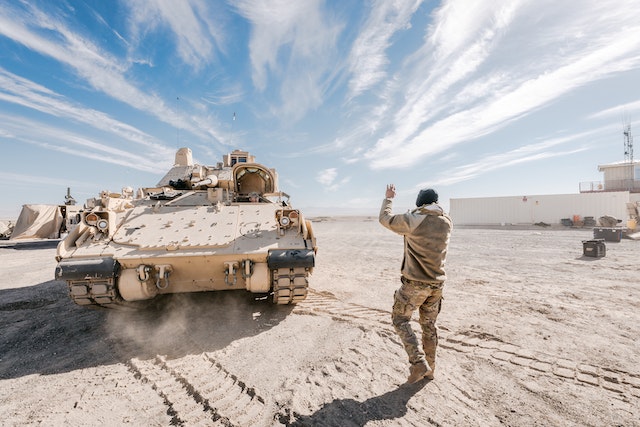
How thick is tank armor? It depends on the tank, the type of armor, and the location on the tank, but armor is roughly between 10 cm at its thinnest and over a meter at its thickest. The tank with the best armor is said to be the Challenger 2. However, for obvious reasons, the actual thickness and makeup of the armor is classified.
The first tanks were invented and used during World War 1. They were not possible until the combustion engine was strong enough to power them. The First World War was fought in trenches and these tanks had to be very long so they could cross the trenches. The goal of the tank was to head to the enemy trench. It was a much different type of fighting to the open terrain fighting that would become common in World War 2.
The object of any tank is to support infantry and to get a powerful gun as close to the enemy as possible. The armor needs to be thick to protect the crew inside the tank. The problem is that in the beginning thicker armor meant more weight and tanks weren’t powerful enough to carry the weight. As the engine became more powerful, they could carry more and more weight, but the power of weapons increased in tandem. It is a constant game of catch up. The thicker and more effective tank armor becomes, the more powerful and more effective the ant-tank weapons become. The armor on a tank is always a tradeoff between speed, firepower, and protection. There is no way to get all three.
The armor on the first generation of tanks was steel plating. It worked against bullets, but as anti-tank guns became more powerful, the armor had to become thicker, and it was just too heavy for the tanks to carry. Then, somebody realized that the angle of the armor made a huge difference in its strength. When a 100 mm piece of steel is set at a flat angle, any projectile has to penetrate 100 mm of armor. If the angle is changed to 45 degrees, the projectile has to penetrate 141 mm of armor. It works because changing the angle of the armor is the same as if the projectile travelled up through the steel plate at an angle of 45 degrees. This realization meant that the thickness of armor could be reduced again, although, counterintuitively, this didn’t reduce the weight of the armor. Angling the armor meant that the plates had to be longer. It did make the steel plates easier to make, which was another advantage.
During World War 2, different types of armor were tried. A tank with aluminium armor was made. It was much lighter and easier to make, but the armor had to be three times as thick to offer the same protection as a steel plate. At the same time, anti-tank weapons were evolving quickly, and solid plates of metal were no longer effective enough. Different countries started to use composite armor. Many different materials have advantages and disadvantages when used as armor. If you combine them, you can increase the advantages while mitigating the disadvantages.
These days, the most protected tank is the Challenger 2 and it uses something called Chobham armor. The name comes from the Chobham Common Research Institute where it was developed in the 1960s. Chobham armor is a composite of metals, plastics, ceramics, and even granite. The actual composition is classified and I know you might think my military security clearances are quite high, but that is beyond even my level. (Apparently, my security clearance will just about let me stand 5 miles outside of a military base. The metals deflect the blast. The ceramics shatter the projectile and take its energy when they shatter themselves. The granite shatters the projectiles. And the plastic fibers trap and pieces of projectile that keep on going through the armor. These types of armor are very effective, but they won’t stop any of the anti-tank weapons that are on the market or a round from another tank.
The armor of the Challenger 2 tank is thickest at the points where they think a shot will most likely come from. That is the mostly at the front, although the sides and back are also heavily reinforced. The armor at the bottom of the tank is thick to ward off landmines and IEDs. The payoff between weight and strength of the armor is ongoing. There is ongoing research into reactive armor. This would have some kind of charge in it and it would explode outwards when it sensed an incoming projectile. The idea would be that the kinetic energy of the projectile was mostly removed before it hit the tank and, if that could be done, less armor would be needed. There is also the likelihood that tanks will be remotely driven in the future, which would negate the need for so much armor because there wouldn’t be a crew that you need to keep alive. And this is what I learned today.
Photo by Art Guzman: https://www.pexels.com/photo/soldier-and-tank-on-desert-10854007/
Source
https://science.howstuffworks.com/m1-tank1.htm
https://aw.my.games/en/news/general/common-tank-myths
https://osgamers.com/frequently-asked-questions/what-tank-has-the-thickest-armor
https://www.britannica.com/technology/tank-military-vehicle/Armor
https://en.wikipedia.org/wiki/Challenger_2
https://en.wikipedia.org/wiki/Main_battle_tank
https://en.wikipedia.org/wiki/Chobham_armor
https://en.wikipedia.org/wiki/Vehicle_armor
https://aplusphysics.com/community/index.php?/blogs/entry/30843-the-physics-of-tank-armor/
https://www.popularmechanics.com/military/weapons/a22623/explained-tank-armor/
